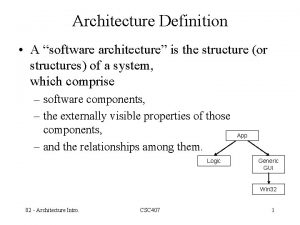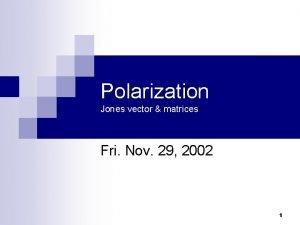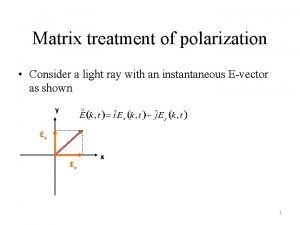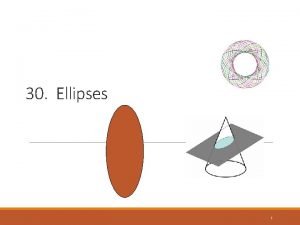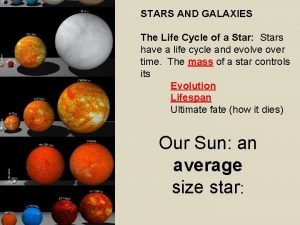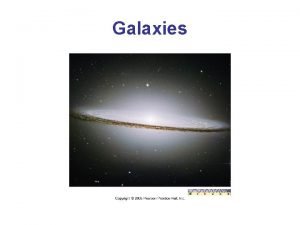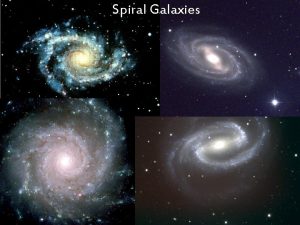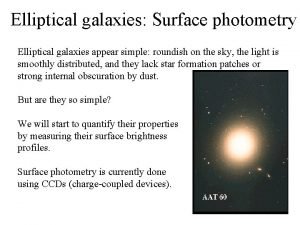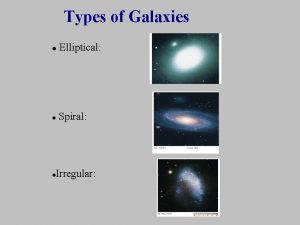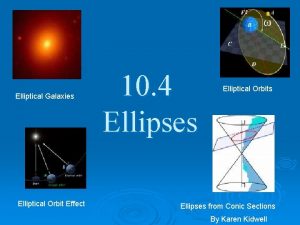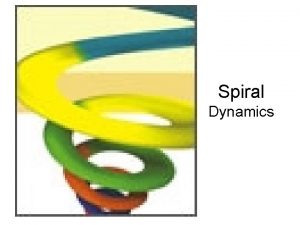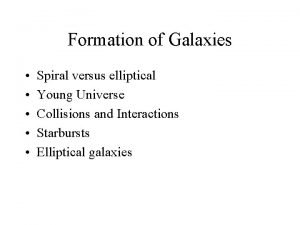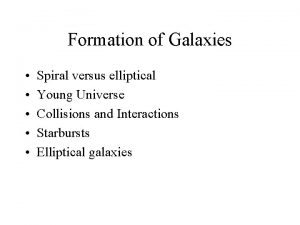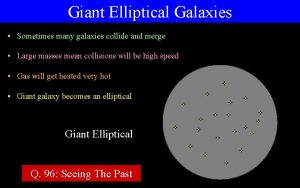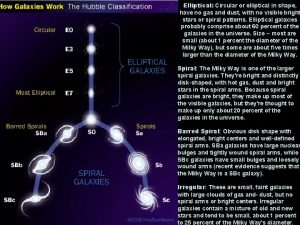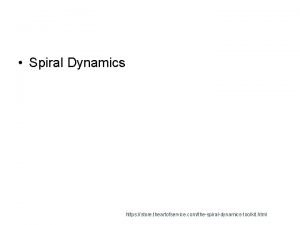Spiral Galaxies Elliptical Galaxies Irregular Galaxies Classification of




![Properties of Galaxies Spirals Ellipticals Irregulars Mass [typical; range] (solar masses) 1011 ; 109 Properties of Galaxies Spirals Ellipticals Irregulars Mass [typical; range] (solar masses) 1011 ; 109](https://slidetodoc.com/presentation_image_h/def665aff88b23569fed60284906209d/image-5.jpg)





















- Slides: 26

Spiral Galaxies

Elliptical Galaxies

Irregular Galaxies

Classification of Galaxies
![Properties of Galaxies Spirals Ellipticals Irregulars Mass typical range solar masses 1011 109 Properties of Galaxies Spirals Ellipticals Irregulars Mass [typical; range] (solar masses) 1011 ; 109](https://slidetodoc.com/presentation_image_h/def665aff88b23569fed60284906209d/image-5.jpg)
Properties of Galaxies Spirals Ellipticals Irregulars Mass [typical; range] (solar masses) 1011 ; 109 - 1012 1011. 5 ; 106 - 1013 1010 ; 108 - 1011 Size (pc) 104 - 105. 5 104 - 106 103 - 105 Color Blue arms, reddish bulge reddish bluish Luminosity 108 - 1010 105 - 1011 107 - 109 Stellar Populations Pops I & II Pop I (Pop II) Interstellar medium Yes Very little Still some Rotation Yes (disk) no Not a lot Fraction 30% 20% 50% Other galaxy types : Peculiar, Interacting, Ring, Starburst, Dwarf, Luminous Infrared, Active Nuclei, Damped Lyman-alpha

Stephan’s Quintet – Colliding galaxies

The “Anntenae” Galaxies – a case study

Galactic Train Wrecks

Collisional Aftermath

Ring Galaxies – the “splash” Head-on collisions can produce a “ripple” of star formation that expands outwards.

Galactic Superwinds

Southern Hemisphere only The Magellanic Clouds

The Galactic Neighborhood

The “Local Group” of Galaxies

Members of the Local Group

And outward…

Galaxy Clusters Virgo Coma Notice the giant ellipticals at the centers of many clusters. These are an example of “galactic cannibalism”.

Galactic Cannibals – Central CD Ellipticals At the heart of rich clusters, galaxies pass through the center and are disrupted and collected.

Making a CD galaxy

into the Universe…

Large Scale Structure On the largest scales (100 million ly) the Universe takes on a “foamy” appearance, with great filaments and walls of galaxies and clusters, surrounding great “voids” that are relatively empty.

Dark Matter - rotation curves Rotation curves imply the mass-to-light ratios of galaxies go up as we look on larger scales: Sun M/L=1, solar neighborhood M/L=3, galaxy M/L=50

Dark Matter – cluster speeds galaxy clusters M/L=200 -500 From average speed of galaxies – the cluster would fly apart From X-ray gas held in – several million degrees and extensive

What could the dark matter be? 1) Normal but dark matter (“baryonic”) : rocks, white or brown dwarfs? 2) Black holes or neutron stars? Too much metals would have been produced. Anyway, there is a fundamental reason from the Big Bang this can’t be it…

Dark Matter : gravitational lensing The mass required to produce the observed lensing is much higher than the luminous mass. This is a direct observation of gravity due to dark matter.

WIMPS and Cold Dark Matter Could dark matter be some kind of new particles which interact very weakly with matter (like neutrinos do) but massive, and not moving relativistically? Experiments at Berkeley and elsewhere are looking for them (guaranteed Nobel prize!).
 Spiral irregular and elliptical galaxies
Spiral irregular and elliptical galaxies Facts about elliptical galaxies
Facts about elliptical galaxies Type of galaxy
Type of galaxy Spiral circle spiral
Spiral circle spiral Definition of software architecture
Definition of software architecture Egg-shaped sewer advantages
Egg-shaped sewer advantages It is a circular or elliptical anticlinal structure
It is a circular or elliptical anticlinal structure Gerunds as appositive
Gerunds as appositive What is elliptical clause
What is elliptical clause “elliptical fin shape.”
“elliptical fin shape.” The cylindrical things is
The cylindrical things is Elliptical adverb clause
Elliptical adverb clause Adjective adverb and noun clauses quiz
Adjective adverb and noun clauses quiz Compound sentence with elliptical construction
Compound sentence with elliptical construction Blood spatter lab
Blood spatter lab Compound sentence with explanatory statement
Compound sentence with explanatory statement Elliptical stab wound
Elliptical stab wound Elliptical examples
Elliptical examples Dangling participle
Dangling participle Jones vector elliptical polarization
Jones vector elliptical polarization Jones vector elliptical polarization
Jones vector elliptical polarization A semi elliptical archway
A semi elliptical archway Waves are produced by stars and galaxies
Waves are produced by stars and galaxies Life cycle of galaxies
Life cycle of galaxies Classification
Classification The pity relation for an adiabatic expansion is
The pity relation for an adiabatic expansion is Most galaxies in the inner region of a large cluster are
Most galaxies in the inner region of a large cluster are




